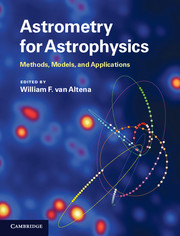Book contents
- Frontmatter
- Contents
- List of contributors
- List of acronyms
- Preface
- Part I Astrometry in the twenty-first century
- Part II Foundations of astrometry and celestial mechanics
- Part III Observing through the atmosphere
- Part IV From detected photons to the celestial sphere
- 13 Geometrical optics and astrometry
- 14 CCD imaging detectors
- 15 Using CCDs in the time-delay integration mode
- 16 Statistical astrometry
- 17 Analyzing poorly sampled images: HST imaging astrometry
- 18 Image deconvolution
- 19 From measures to celestial coordinates
- 20 Astrometric catalogs: concept, history, and necessity
- 21 Trigonometric parallaxes
- Part V Applications of astrometry to topics in astrophysics
- Index
- References
19 - From measures to celestial coordinates
from Part IV - From detected photons to the celestial sphere
Published online by Cambridge University Press: 05 December 2012
- Frontmatter
- Contents
- List of contributors
- List of acronyms
- Preface
- Part I Astrometry in the twenty-first century
- Part II Foundations of astrometry and celestial mechanics
- Part III Observing through the atmosphere
- Part IV From detected photons to the celestial sphere
- 13 Geometrical optics and astrometry
- 14 CCD imaging detectors
- 15 Using CCDs in the time-delay integration mode
- 16 Statistical astrometry
- 17 Analyzing poorly sampled images: HST imaging astrometry
- 18 Image deconvolution
- 19 From measures to celestial coordinates
- 20 Astrometric catalogs: concept, history, and necessity
- 21 Trigonometric parallaxes
- Part V Applications of astrometry to topics in astrophysics
- Index
- References
Summary
Introduction
The goal of this book is to present an introduction to the techniques of astrometry and to highlight several applications of those techniques to the solution of current problems of astrophysical interest. In some cases we require the absolute positions of objects to establish reference frames and systems, while in others we need the change in position with time to obtain the distances and tangential velocities of the objects. The astrometric procedures necessary to solve those problems have been laid out in considerable detail by Konig (1933, 1962), Smart (1931), and others, so we will summarize the methods used to transform raw coordinate measurements of celestial objects on photographic plates and CCDs to their corresponding coordinates on the celestial sphere. We recommend that the reader consult the above references where clarification is needed. Once we have the desired celestial coordinates and their changes with time that yield parallaxes and proper motions, we can then create catalogs of those quantities and apply them to the solution of problems in galactic structure, the masses of stars, membership in star clusters, dynamical studies of objects in the Solar System, and extrasolar planets, and to help to set limits to some cosmological models.
Telescope and detector alignment
We normally assume that our telescope and detector have been carefully aligned so that the image quality will be optimum over the field of view (FOV). However, even if the apparent image quality is good over the FOV, it may be that residual misalignments remain that complicate the transformation from detector to sky. Quite often, high-order polynomials are used to absorb the effects of those misalignments. Unfortunately, that procedure obscures the interpretation of the transformation terms and can lead to spurious and/or lower-accuracy results.
- Type
- Chapter
- Information
- Astrometry for AstrophysicsMethods, Models, and Applications, pp. 277 - 296Publisher: Cambridge University PressPrint publication year: 2012
References
- 1
- Cited by



